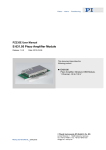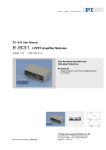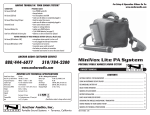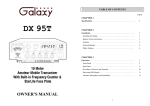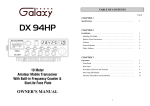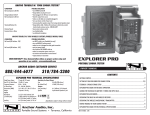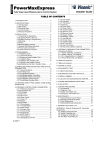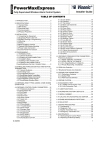Download DELTA PA - Lightspeed Technologies, Inc.
Transcript
DELTA PA ON Portable Amplification System User Manual TABLE OF CONTENTS SECTION 1: 4 Safety Instructions 5 6 7 8 9 10 System Components and Unpacking Optional Components Top Panel Wireless Receiver Controls Top Panel Controls & Connections Rear Panel Controls & Connections Installing or Replacing Receiver Module SECTION 2: 11 Set-up & Use 12 13 Step 1. Connecting the DELTA PA Receiver to a Power Supply Step 2A. Setting up one DELTA PA Receiver Step 2B. Using More Than One DELTA PA Receiver Handheld Transmitter Step 3. Channel Selection Step 4. Battery Life & Battery Type Step 5. Replacing Battery Step 6. Recharging Batteries Belt-pack Step 7. Connecting & Placement Step 8. Channel Selection Step 9. Gain Adjust Step 10. Battery Life Indicator & Type Step 11. Replacing Batteries Step 12. Recharging Batteries Daily Use Instructions Overview 14 15 16 17 18 19 20 21 22 23 24 SECTION 3: 25 Optional Accessories 26 Hand Held Microphone Transmitter Belt-Pack Transmitter SECTION 4: Troubleshooting 27 Troubleshooting Guide SECTION 5: Warranty & Specifications 28 29 30 Warranty Statement Safety Warnings System Specifications 5. Warranty, Safety & Specifications 4. Troubleshooting 3. Optional Accessories IMPORTANT SAFETY INSTRUCTIONS 1. Read these instructions. 2. Keep these instructions. 3. Heed all warnings. 4. Follow all instructions. 5. Do not use the apparatus near water. 6. Clean only with dry cloth. 7. Do not block any ventilation openings. Install in accordance with the manufacturer’s instructions. 8. 1. Overview 2. Setup & Use 9. Do not install near any heat sources such as radiators, heat registers, stoves, or other apparatus (including amplifiers) that produce heat. Do not defeat the safety purpose of the polarized or grounding-type plug. A polarized plug has two blades with one wider than the other. A grounding- type plug has two blades and a third grounding prong. The wide blade or the third prong is provided for your safety. If the provided plug does not fit into your outlet, consult an electrician for replacement of the obsolete outlet. 10. Protect the power cord from being walked on or pinched particularly at plugs, convenience receptacles, and the point where they exit from the apparatus. 4 11. Only use attachments/ accessories specified by the manufacturer. 12. Use only with a cart, stand, tripod, bracket or table specified by the manufacturer, or sold with the apparatus. When a cart is used, use caution when moving the cart/apparatus combination to avoid injury from tip-over. 13. Unplug this apparatus during lightning storms or when unused for long periods of time. 14. Refer all servicing to qualified service personnel. Servicing is required when the apparatus has been damaged in any way, such as power-supply cord or plug is damaged, liquid has been spilled or objects have fallen into the apparatus, the apparatus has been exposed to rain or moisture, does not operate normally, or has been dropped. 15. When the mains plug or appliance coupler used as the disconnect device, it shall remain readily operable. 16. Please keep the unit in a good ventilation environment. OVERVIEW SYSTEM COMPONENTS AND UNPACKING The standard configuration of the DELTA PA will contain: 1. Overview 2. Setup & Use 3. Optional Accessories DELTA PA Public Address System and Power Supply 4. Troubleshooting 5. Warranty, Safety & Specifications SECTION 1: ON TX-HM016 Transmitter DELTA PA Carry Case 5 5. Warranty, Safety & Specifications OPTIONAL COMPONENTS Optional equipment which may be part of your DELTA PA system: 1. Overview 2. Setup & Use 3. Optional Accessories 4. Troubleshooting TX-BP016 Transmitter and Charger 6 MC-TK270S NoiseCancelling Headset Microphone MC-831S Audio -Technica 831 Lapel Mic Individual Components RX-DPA016R TX-HM016 AC-MH7 TX-BP016 BC-TX900 MC- 831S MC-TK270S PS-24V-2.5-A BA-NH1 AC-SPDELTA-X6 AC-PWR-NA 16 Channel UHF Receiver Module 16 Channel UHF Handheld Transmitter Mic Clip for HM016 Handheld Transmitter 16 Channel UHF Belt-Pack Transmitter Battery Charger for BP016 or HM016 Audio-Technica 831 Lapel Mic Lightspeed Noise-cancelling Headset Mic AC Power Supply AA NiMH Rechargeable Battery Carry Bag for DELTA PA AC North American Power Cable Optional Accessories CA-GTC900 AC-TWBRK AC-SS1 AC-SPSS1 MC-H10 Guitar/aux In Cable for BP016 Speaker Stand Bracket Tripod Speaker Stand Carry Bag for Tripod Speaker Stand Wired Dynamic Handheld Mic 2 GREEN: ON CHARGE GREEN: FULL RECVR 1 5 1 4 7 1. WIRELESS RECEIVER 1: One or two wireless receiver modules are located at the top panel. 2. CHANNEL DISPLAY: An LED readout of the receiver module indicates which channel you are on. 3. CHANNEL CONTROL (1-16): The left button increments the channel number (1-16). Each touch of the button moves the number up one until it gets to sixteen. The right button decrements the channel number (16-1). 4. RF CHANNEL A/B INDICATOR: The “A” LED lights up indicating the A channel tuner is receiving the strongest RF signal. The “B” LED lights up indicating the “B” channel tuner is receiving the strongest RF signal. 5. Warranty, Safety & Specifications 6 3. Optional Accessories O/I POWER/ RECVR 1 RED: LOW BATT 5. TRANSMITTER LOW BATTERY INDICATOR: This LED will light to indicate the batteries in the corresponding transmitter are low. 2. Setup & Use 3 RECVR 2 POWER 1. Overview RECVR 2 RED: CHARGING 4. Troubleshooting TOP PANEL: WIRELESS RECEIVER CONTROLS 6.SCAN: Press this button to automatically select a channel that is free from interference. 7. SQUELCH LEVEL ADJUSTMENT: Covered with a plastic cap, the squelch is adjusted at the factory to provide the best signal level and minimum noise. There is no need to adjust the squelch level in the field. 7 1 4. Troubleshooting 5. Warranty, Safety & Specifications TOP PANEL CONTROLS AND CONNECTIONS 2 RECVR 2 3. Optional Accessories 3 4 RECVR 2 O/I POWER/ RECVR 1 5 POWER RED: LOW BATT GREEN: ON CHARGE 2. Setup & Use RED: CHARGING GREEN: FULL RECVR 1 6 1. Overview 7 1.BASS: Controls the level of low frequency sound output for the system. 2. TREBLE: Controls the level of high frequency sound output for the system. NOTE: Reducing Feedback The BASS and TREBLE controls can be used to reduce feedback (“squealing” or “howling”). If you hear high-pitched squealing, lower the treble setting. If you hear lowpitched howling, lower the bass setting. 3. AUX IN/MIC IN: Controls the volume of a wired microphone plugged into MIC IN on the back of the system and the volume of an auxiliary piece of equipment plugged into the AUX IN on the back of the system. 4. WIRELESS RECVR 2: Controls the volume of Wireless Microphone 2 if a second wireless receiver is installed. 5. POWER/WIRELESS RECVR 1: Turn this knob clockwise to power up the system. Rotate to adjust the volume of Wireless Microphone 1. 6. POWER LED: Green = Power On. Red = Low Battery 7. CHARGING LED: Green = Full Charge. Red = Charging 8 4. Troubleshooting 1 5. Warranty, Safety & Specifications REAR PANEL CONTROLS AND CONNECTIONS 2 3 5 6 3. Optional Accessories 4 1. MIC IN: This ¼” jack provides an input for a wired handheld microphone. 2. AUX IN: This 3.5 mm jack provides an input for audio from an external device, such as a CD player, MP3 player, TV/VCR, computer, etc. 3. AUX OUT: This 3.5 mm jack provides an adjustable-level audio output that can be connected to a recorder or assistive listening device. a line level output signal that can be connected to a recorder, assistive listening device, etc. 1. Overview 8 2. Setup & Use 7 6. SPEAKER OUT (SWITCHED): This ¼” jack can be used to connect to an external passive speaker. [NOTE: connection to this jack will mute the internal speaker of the DELTA PA.] *Note: Wiring to these terminals should follow the Class 2 wiring methods as outlined in the National Electric Code. 4. AUX OUT VOLUME: This knob controls the level of the 3.5 mm AUX OUT jack. Counterclockwise represents a microphone level signal, while fully clockwise represents a line level signal. 7.FUSE: The fuse holder is accessible using a flat-blade screwdriver. Push in and rotate ¼ turn counterclockwise to remove. [NOTE: replacement is a 3.15A SB 250V slow blow fuse.] 5. AUX OUT: This ¼” jack provides 8. DC POWER: This jack provides a connection for the DELTA PA power supply. 9 5. Warranty, Safety & Specifications 4. Troubleshooting 3. Optional Accessories NOTE: Make sure the DELTA PA is turned off. 1. Remove the two screws securing the module panel using a small phillips head screwdriver. 2. Remove the module from the enclosure by carefully inserting the blade of a small, flat-blade screwdriver under the face plate edge and nudging it upward. 3. Grasp the edges of the module with both hands and slide it out. 4. Install the new module by aligning it with the guide rails and sliding all the way in to engage the connector at the rear of the module. 5. Replace the two screws. 1. Overview 2. Setup & Use INSTALLING OR REPLACING A RECEIVER MODULE RECVR 2 RECVR 2 O/I POWER/ RECVR 1 10 POWER RED: LOW BATT GREEN: ON 1. CONNECTING THE DELTA PA RECEIVER TO A POWER SUPPLY Note: When the DELTA PA is received, plug in the power supply and let charge overnight before using. 1.Locate the power supply. 2. Setup & Use 3. Optional Accessories 2.Insert the DC connector into the “POWER INPUT” connector on the bottom of the DELTA PA and plug the other end to an electrical outlet. 5. Warranty, Safety & Specifications SET-UP & USE 4. Troubleshooting SECTION 2: 1. Overview RECVR 2 3.Turn the POWER/RCVR1 knob clockwise to turn the system on. 4.The GREEN LED light next to the knob will illuminate to confirm the system is powered up. RECVR 2 RECVR 2 RECVR 2 O/I POWER/ RECVR 1 POWER RED: LOW BATT GREEN: ON CHARGE RED: CHARGING O/I POWER/ RECVR 1 POWER RED: LOW BATT GREEN: ON CHARGE GREEN: FULL RED: CHARGING GREEN: FULL RECVR 1 11 RECVR 2 RECVR 2 1. Turn the DELTA PA ON by rotating the POWER/RCVR 1 knob clockwise. The GREEN LED will light. O/I POWER/ RECVR 1 POWER RECVR 2 RED: LOW BATT O/I POWER/ RECVR 1 GREEN: ON CHARGE POWER RED: LOW BATT GREEN: ON CHARGE RED: CHARGING GREEN: FULL RED: CHARGING GREEN: FULL Channel Selection: Receiver Each Receiver has 16 user-selectable channels to choose from. You can either select a channel manually or by pressing the SCAN button, which will automatically select a clear channel. RECVR 1 2. Clear Channel SCAN (recommended): A) Make sure the transmitter(s) is OFF before pressing this button. When this button is pressed, the receiver will cycle through all 16 channels and select a clear frequency. (This process takes about 20 seconds.) B) Once the receiver selects the clear channel, you will need to select the same channel on the corresponding transmitter (handheld or belt-pack). See pages 14 and 19 for instructions. NOTE There are 3 different groupings of 16 channels available (620, 640, 660 MHz). Make sure the receiver module frequency group is the same frequency group as the transmitter. 12 RECVR 2 RECVR 1 1. Overview 2. Setup & Use 3. Optional Accessories 4. Troubleshooting 5. Warranty, Safety & Specifications 2A. SETTING UP ONE DELTA PA RECEIVER ON Channel 2 5. Warranty, Safety & Specifications 2B. USING MORE THAN ONE DELTA PA RECEIVER A) Verify that RECVR 1 transmitter and receiver 1 are ON and set to the same clear channel. B) Make sure the transmitter for RECVR 2 is turned OFF. C) Press the SCAN button on the RECVR 2. D) After the RECVR 2 receiver selects a clear channel, set the RECVR 2 transmitter (handheld or belt-pack) to the selected channel. See pages 14 and 19 for instructions. 3. Optional Accessories 4. Troubleshooting If you have a second DELTA PA: A) Pressing the UP CHANNEL button increases the channel number by one. B) Pressing the DOWN CHANNEL button decreases the channel number by one. C) Once a frequency is selected, you will need to select the same channel on the corresponding transmitter (handheld or beltpack). See pages 14 and 19 for instructions. 1. Overview 2. Setup & Use 3. Manual Channel Selection: ON 4. Set the Receiver 1 and Receiver 2 channels on the second DELTA PA to be the same as the first DELTA PA. Channel 2 13 5. Warranty, Safety & Specifications 4. Troubleshooting 3. CHANNEL SELECTION: HANDHELD TRANSMITTER Once a channel has been selected on the receiver, you now need to select that same channel on the handheld transmitter. If you have a belt-pack transmitter, go to page 19 for channel selection instructions. ON 1. Turn on the microphone by sliding the power button on the barrel forward. 2. Use a screwdriver to set the channel switch to the current channel shown on the RECVR screen. 1. Overview ON 2. Setup & Use 3. Optional Accessories Same Channel Transmitters and receivers are available in 3 different frequency groups (620, 640, 660 MHz). Verify that the receiver frequency matches the letter code on the silver sticker in the battery compartment of the transmitter. Model Number: HM016 Serial Number HM01614324024 FREQUENCY 660 MADE IN TAIWAN Frequency 14 5. Warranty, Safety & Specifications 4. BATTERY LIFE INDICATOR AND BATTERYTYPE ON HANDHELD MICROPHONE 4. Troubleshooting Battery Life Indicator The battery low indicator lights red when the battery charge is low. 3. Optional Accessories ON Low Battery Light 1. Overview The transmitter will operate with either standard AA alkaline batteries or nickel metal hydride (NiMH) rechargeable batteries. Since these types of batteries have different characteristics, it is important not to mix battery types. Use only AA NiMH batteries when recharging. 2. Setup & Use Battery Type NOTE: Do not mix battery types. WARNING: Do not use NiCad batteries! They will not charge properly and may cause damage to the transmitter. Lightspeed recommends Panasonic or Energizer batteries. Duracell may not work. 15 5. Warranty, Safety & Specifications 5. REPLACING BATTERIES IN HANDHELD MICROPHONE 1. Overview 2. Setup & Use 3. Optional Accessories 16 1. Unscrew the end cap to reveal the battery compartment. 2. Remove or replace the batteries as shown. The microphone requires two AA sized batteries stacked end to end. 3. Note the polarity in the battery compartment. IMPORTANT: Replace batteries with the same type, (alkaline or NiMH), that were installed in your Handheld Microphone. Lightspeed recommends Panasonic or Energizer batteries. Duracell may not work properly. ON 4. Troubleshooting Replacing the Batteries 4. Troubleshooting Recharging the Batteries (NiMH Rechargeable Batteries ONLY): ON 2. Setup & Use 1. Switch the transmitter power OFF. 3. Optional Accessories Make sure there are NiMH rechargeable batteries in the transmitter before plugging in the charger. A full charge will be attained in 8-10 hours. Fully charged Lightspeed microphones will last over 7 hours. WARNING: Do not attempt to charge alkaline batteries. They can overheat and expand, creating a significant hazard and damaging the transmitter. (This is not covered by warranty.) 5. Warranty, Safety & Specifications 6. RECHARGING BATTERIES IN HANDHELD MICROPHONE 3. Plug the other end of the charger into any standard 110 VAC outlet. 4. The RED LED on the charger will light, indicating that charging is in progress. 1. Overview 2. Insert the small DC plug into the jack on the bottom of the transmitter. 5. When the batteries are fully charged, the LED on the charger will glow GREEN. 17 5. Warranty, Safety & Specifications 7. CONNECTING AND PLACING BELT-PACK TRANSMITTER 1. Overview 2. Setup & Use 3. Optional Accessories 4. Troubleshooting Connecting the Microphone To connect the microphone, simply insert the microphone connector into the TA4F connector on top of the transmitter. To remove, press the black button on the microphone connector and pull out. Microphone Options Lightspeed offers various types of microphones that can be used with this system. The BP016 Transmitter can be used with either a lapel style microphone or a headset microphone. Both plug into the top of the transmitter as shown. Lapel Microphone Placement Several varieties of lapel microphones are available. Simply connect the microphone cord directly into the jack on top of the transmitter and clip the microphone to lapel or collar. For optimal sound, position the microphone as close to the mouth as possible. Headset Microphone Placement Several varieties of headset microphones are available. Simply connect the microphone cord directly into the jack on top of the transmitter and place the headset around the back of the head. For optimal sound, position the microphone at the corner of the mouth. 18 5. Warranty, Safety & Specifications 8. CHANNEL SELECTION: BELT-PACK TRANSMITTER Channel Selection: 4. Troubleshooting Once a channel has been selected on the receiver, you now need to select that same channel on the Beltpack transmitter. 1. Turn the transmitter power ON by sliding the PWR button to ON. 2. Setup & Use 3. Optional Accessories 2. Open the battery compartment door by depressing the latches on each side of the transmitter. 1. Overview 3. Use the screwdriver channel set to switch to the current channel shown on the receiver. Transmitters and receivers are available in 3 different frequency groups (620, 640, 660 MHz). Verify that the frequency group of the receiver matches the letter code on the silver sticker in the battery compartment of the transmitter. Model Number: BP016 Serial Number BP01614324024 FREQUENCY 660 MADE IN TAIWAN 19 5. Warranty, Safety & Specifications 9. GAIN ADJUST ON BELT-PACK TRANSMITTER 4. Troubleshooting Gain Adjust: When changing microphones or users, it may be necessary to adjust the transmitter gain based on differing microphones sensitivities and voice levels. 1. Open the battery compartment door by depressing the latches on each side of the transmitter. 2. Turn the MT dial clockwise to increase the gain and counterclockwise to decrease the gain. 1. Overview 2. Setup & Use 3. Optional Accessories To adjust the gain: NOTE: If you are using a high impedance source, such as a guitar, it will be necessary to adjust the GT dial. Using a high impedance source requires a special cable. Contact Lightspeed Customer Service at 800732-8999 for more information. 20 5. Warranty, Safety & Specifications 10. BATTERY LIFE INDICATOR AND TYPE ON BELT-PACK TRANSMITTER Battery low indicator is located next to the power switch. It glows red when the battery charge is low and recharging is necessary. 4. Troubleshooting Battery Life Indicator 2. Setup & Use The transmitter will operate with either standard AA alkaline batteries or nickel metal hydride (NiMH) rechargeable batteries. Since these types of batteries have different characteristics, it is important not to mix battery types. use only AA NiMH batteries when recharging. 3. Optional Accessories Battery Type WARNING: Do not use NiCad batteries! They will not charge properly and may cause damage to the transmitter. Lightspeed recommends Panasonic or Energizer batteries. Duracell may not work. 1. Overview NOTE: Do not mix battery types. 21 5. Warranty, Safety & Specifications 11. REPLACING BATTERIES IN BELT-PACK TRANSMITTER 1. Overview 2. Setup & Use 3. Optional Accessories 4. Troubleshooting Replacing the Batteries: 22 1. Open the battery compartment door by depressing the latches on each side of the transmitter. 2. Remove or replace the batteries and snap the door shut. The belt-pack requires two AA sized batteries. 3. Note the polarity in the battery compartment. IMPORTANT: Replace batteries with the same type, (alkaline or NiMH), that were installed in your Handheld Microphone. Lightspeed recommends Panasonic or Energizer batteries. Duracell may not work properly. WARNING: Do not attempt to charge alkaline batteries. They can overheat and expand, creating a significant hazard and damaging the transmitter. (This is not covered by warranty.) 1. Switch the transmitter power OFF. 2. Insert the small DC plug into the jack on the side of the transmitter. 3. Plug the other end of the charger into any standard 110 VAC outlet. 4. The RED LED on the charger will light, indicating that charging is in progress. 5. Warranty, Safety & Specifications 4. Troubleshooting 3. Optional Accessories Make sure there are NiMH rechargeable batteries in the transmitter before plugging in the charger. Typical battery life is about 8 hours. Fully charged Lightspeed transmitters will last over 7 hours. A full charge will be attained in 8-10 hours. 2. Setup & Use Recharging the Batteries (NiMH Rechargeable Batteries ONLY): 1. Overview 12. RECHARGING BATTERIES IN BELT-PACK TRANSMITTER 5. When the batteries are fully charged, the LED on the charger will glow GREEN. 23 5. Warranty, Safety & Specifications 4. Troubleshooting 3. Optional Accessories 2. Setup & Use 1. Overview DAILY USE INSTRUCTIONS 1. Wireless Microphone Operation RF Indicator Lights: When both the system and the transmitter are ON and operating on the same channel you will see a BLUE glowing RF Indicator Light (either A or B) on the receiver. 2. VOLUME ADJUSTMENT: While speaking into the microphone, slowly turn the RECVR1 volume knob (or RECVR2, depending on which microphone you are operating) clockwise until you reach the desired level. NOTE: Do not stand directly in front of the DELTA PA speaker with the microphone on. This will result in feedback or ‘squealing.’ It is best to stand behind or to the side of the unit when setting volume level. 3. SQUELCH ADJUSTMENT: Adjusting the squelch level may be necessary to block out potential interference in areas that have that have very high radio traffic. • Maximum squelch (full clockwise) reduces reception range but also reduces the potential for system interference. • Minimum squelch (full counterclockwise) increases reception range, but also increases the potential for system interference. NOTE: In most cases it will not be necessary to adjust the squelch level. The system already has a clear channel scanner to take care of most interference problems. 4. TRANSMITTER LOW BATTERY INDICATOR: This LED will light to indicate the batteries in the corresponding transmitter are low and need to be replaced or recharged. 24 RECVR 2 RECVR 2 RECVR 2 O/I POWER/ RECVR 1 POWER RED: LOW BATT RECVR 2 GREEN: ON CHARGE RED: CHARGING GREEN: FULL O/I POWER/ RECVR 1 POWER RED: LOW BATT GREEN: ON CHARGE RED: CHARGING GREEN: FULL RECVR 1 RECVR 1 OPTIONAL ACCESSORIES 3. Optional Accessories 4. Troubleshooting HANDHELD MICROPHONE TRANSMITTER 5. Warranty, Safety & Specifications SECTION 3: 3 4 1. RED LED: Lights up briefly when power is switched on, flashes continuously when audio is muted. 1. Overview 2 2. Setup & Use ON 1 2. POWER ON/OFF: Turns the audio ON and OFF. The RED LED will flash when power is turned ON. 3. CHANNEL SWITCH: A screwdriver adjust to set channel 1-16 to match the channel setting of its receiver. 4. BATTERY COMPARTMENT: Bottom section of microphone barrel unscrews to reveal battery compartment. 25 5. Warranty, Safety & Specifications 2 3 4 1 9 6 5 3. Optional Accessories 4. Troubleshooting BELT-PACK TRANSMITTER 1. Overview 2. Setup & Use 7 1. ON/OFF BUTTON 6 compartment door. 2. RED LED: Lights up briefly when power is switched ON, flashes continuously when audio signal is muted. 7. GT (TRANSMITTER GAIN): Provides adjustment for differing voice levels and microphone sensitivities. 3. MICROPHONE JACK: Microphone connects to transmitter here. 8. MT (MICROPHONE GAIN): Provides adjustment for differing voice levels and microphone sensitivities. 4. ANTENNA 5. BATTERY CHARGER JACK: Optional battery charger plugs in here (for NiMH batteries only.) 6. DOOR LATCHES: Press both latches to open the battery 26 8 10 9. CHANNEL SET SWITCH: Screwdriver adjust to set the channel 1-16 to match its receiver channel. 10. BATTERY COMPARTMENT No sound when someone speaks into the wireless microphone: 1. DELTA PA power should be ON. The GREEN LED should be lit. If it does not light when the system is switched on, make sure the AC power supply is plugged in. 2. Microphone/transmitter power should be ON. If the low battery indicator is on (red) the batteries are most likely too weak. If the batteries are rechargeable, plug the microphone/transmitter into the charger. If the batteries are alkaline, replace them with new alkaline batteries WARNING: Do not attempt to charge alkaline batteries. They can overheat and expand, creating a significant hazard and damaging the warranty. (This is not covered by warranty.). 3. The transmitter and receiver should be set to the same channel. The BLUE RF LED (A or B) should be lit. 4. Make sure the MUTE light is not flashing. Switch the transmitter/ microphone off of MUTE. 5. Verify that receiver and transmitter are in the same frequency group. Turn the DELTA PA OFF and then ON again. The letter code from the frequency group will blink on the receiver module. Open the battery compartment on the transmitter and be sure that frequency group printed on the sticker matches the frequency group letter code that blinked when the DELTA PA powered ON. If the letters are different, find a microphone or belt-pack with the same frequency group as the receiver indicates when the DELTA PA is turned ON. The wireless mic is experiencing drop-out or interference: 1. The wireless frequency being used may not be a clear channel. Turn the transmitter OFF and press the SCAN button on the receiver to find a clear frequency. Then select the same channel on the transmitter. 2. Transmitter is out of range of receiver. The transmitters have a maximum range of about 300-350 feet in an open field environment. This range can be dramatically reduced indoors and outdoors when large objects (such as a wall) may be obstructing the path directly between transmitter and receiver. If so, position the two closer together. 3. Batteries are very weak. Right before the batteries are about to die, the overall performance of the system can be drastically lessened. Check the battery status of the transmitter. Low Volume or Feedback: 5. Warranty, Safety & Specifications 4. Troubleshooting Note: Most problems are directly related to low battery power. Please run through the “Battery Check” items first. For remaining troubleshooting, use known good, fully-charged batteries. 3. Optional Accessories COMMON PROBLEMS AND SOLUTIONS 2. Setup & Use TROUBLESHOOTING 1. Overview SECTION 4: 1. Ensure microphone is positioned appropriately. 2. Check volume level on the amplifier. If the volume is too high, feedback will occur. Adjust accordingly. If you review these instructions and still have questions, write down the serial number and model number of your system and call Lightspeed Technical Services at 800.732.8999, 5 a.m. – 5 p.m., PST. 27 5. Warranty, Safety & Specifications 4. Troubleshooting 3. Optional Accessories 2. Setup & Use 1. Overview SECTION 5: WARRANTY, SAFETY & SPECIFICATIONS THREE-YEAR LIMITED WARRANTY Lightspeed Classroom Audio Systems are guaranteed against malfunction due to defects in materials and workmanship for a period of THREE (3) YEARS, beginning at the date of the purchase invoice. If such malfunction occurs, the product will be repaired or replaced (at Lightspeed’s option) without charge during the warranty period, subject to the following conditions: 1. The product must have been purchased from an authorized Lightspeed Technologies Dealer or representative. 2. Lightspeed Technologies must perform all warranty service. Any service performed without the authorization of Lightspeed Technologies will void the entire warranty. bulbs, or any other failings due to normal wear. 5. Warranty is void when equipment is subjected to adverse temperature, humidity, moisture, or other conditions that are not considered normal environmental conditions. 6. This warranty excludes all damages or defects caused by shipping, transporting, or inadequate packaging for shipping. 7. Customers are responsible for freight charges to Lightspeed Technologies for service. Lightspeed Technologies will pay for return freight to the end user by most reasonable method. The warranty period for each system and component type is listed below: 3. This warranty does not cover any product that has been subjected to negligent use, connection to improper power source, misuse, or operated beyond its manufactured specifications and limits, or has not been reasonably maintained. DELTA PA: Three (3) years from the date of original purchase. 4. Warranty shall not apply to alkaline or NiMH batteries, exterior finish, AC power cords, Microphones and Cases: One (1) year from date of purchase. RF Wireless Transmitters and Receivers: Three (3) years from the date of purchase. NiMH Batteries: One (1) year from the date of purchase. Products will be replaced or repaired at Lightspeed Technologies’ option during the warranty period. For warranty service, please contact Lightspeed Customer Service Department to obtain return authorization approval and an RA number. Our Service Department (800.732.8999, 5 a.m. – 5 p.m., PST) will handle all your repair/replacement needs. 28 5. Warranty, Safety & Specifications SAFETY WARNINGS FCC Caution This device complies with Part 15 of the FCC Rules. Operation is subject to the following two conditions: (1) This device may not cause harmful interference, and (2) This device must accept any interference received, including interference that may cause undesired operation. To assure continued compliance, any changes or modifications not expressly approved by the party responsible for compliance could void the user’s authority to operate this equipment. (Example - use only shielded interface cables when connecting to computer or peripheral devices). DELTA PA & BP016 & HM016 IC ID Caution 3. Optional Accessories This product is listed to UL standards and requirements for electrical safety by Underwriters Laboratories Inc. 2. Setup & Use The exclamation point within an equilateral triangle is intended to alert the user to the presence of important operating and maintenance (servicing) instructions in the literature accompanying the appliance. 1. Overview The lightning flash with arrowhead symbol within an equilateral triangle is intended to alert the user to the presence of uninsulated “dangerous voltage” within the product’s enclosure, that may be sufficient magnitude to constitute a risk of electric shock. 4. Troubleshooting LIGHTSPEED TECHNOLOGIES, INC. PH: 1.800.732.8999 This device complies with Industry Canada licence-exempt RSS-123 standard. Operation is subject to the following two conditions: (1) this device may not cause interference, and (2) this device must accept any interference, including interference that may cause undesired operation of the device. BP016 & HM016 FCC Caution THIS DEVICE COMPLIES WITH PART 74 OF THE FCC RULES. This equipment complies with FCC RF radiation exposure limits set forth for an uncontrolled environment. 29 5. Warranty, Safety & Specifications 4. Troubleshooting 3. Optional Accessories 2. Setup & Use 1. Overview 30 SYSTEM SPECIFICATIONS OVERALL SPECIFICATIONS Nominal SPL [1W/1M] Maximum SPL System Power [RMS] Music Power [RMS] Amplifier Type Frequency Response of amplifier Speaker System Microphone Input Wireless Microphones Line Input Line Output Tone Controls Speaker Output Dimensions [H x W x D inches] Weight 89 dB 102 dB 30 W at 2 Ω 40 W at 2 Ω Analog Class AB 90 Hz - 18 kHz Full-Range 6.5”/4 Ω ¼ inch phone jack Up to two 16-Channel UHF True Diversity 3.5 mm 3.5mm and ¼ inch Bass and Treble 1 switched 2 Ω 9.75 x 12.5 x 6.25 7.2 lbs./20.4 kg Micro Frequency Range Selectable Frequencies Deviation Sensitivity Tone-code Frequency Image Rejection S/N Ration [Max] TRANSMITTER SPECIFICATIONS HM-016 Handheld Microphone RF Power Output 50 mW Maximum Spurious Emission Macro Frequency Range >60 dB below the carrier 620 MHz to 679.75 MHz [3 Macro-Groups] Selectable Frequencies Tone-Code Frequency Pre-Emphasis Limiter Range Battery Type Battery Life [Alkaline] Weight w/o Batteries 16 32.768 KHz 50 µsec >30 dB or audio overload 2 AA Approx. 8 Hours 4.2 oz/120 g BP-016 Belt-pack RF Power Output Spurious Emission Macro Frequency Range Selectable Frequencies Tone-Code Frequency Pre-Emphasis Limiter Range Battery Type Battery Life [Alkaline] Microphone Connector Weight w/o Batteries 50 mW Maximum >60 dB below the carrier 620 MHz to 679.75 MHz [3 Macro-Groups] 16 32.768 KHz 50 µsec >30 dB or audio overload 2 AA Approx. 8 Hours TA4F 3 oz/85 g 5. Warranty, Safety & Specifications 4. Troubleshooting Macro Frequency Range Microprocessor Controlled PLL Synthesized 620 to 679.75 MHz [3 Macro-Groups] 25 MHz each Macro-Group 16 ± 40 KHz Nominal -100 dBm at S/N ratio of >80 dB 32.768 KHz >85 dB >105 dB 3. Optional Accessories Carrier System 2. Setup & Use RECEIVER SPECIFICATIONS 1. Overview SYSTEM SPECIFICATIONS CONT’D CHANNEL FREQUENCY ASSIGNMENT EE HH LL 620.000 - 639.750 640.000 - 659.750 660.000 - 679.750 31 LI GHTSPEED TE C HNOL OG I E S 11509 SW HER M A N R OA D / T UA LAT IN , OR 9 7 0 6 2 TOLL F REE: 80 0 .7 3 2 .8 9 9 9 / P H ON E : 5 0 3 .6 8 4 . 5 5 3 8 / FAX : 503.684.3197 LIGHTSPEED-T E K .COM MN0374US01-3



































